fagor 8055 Programming Manual
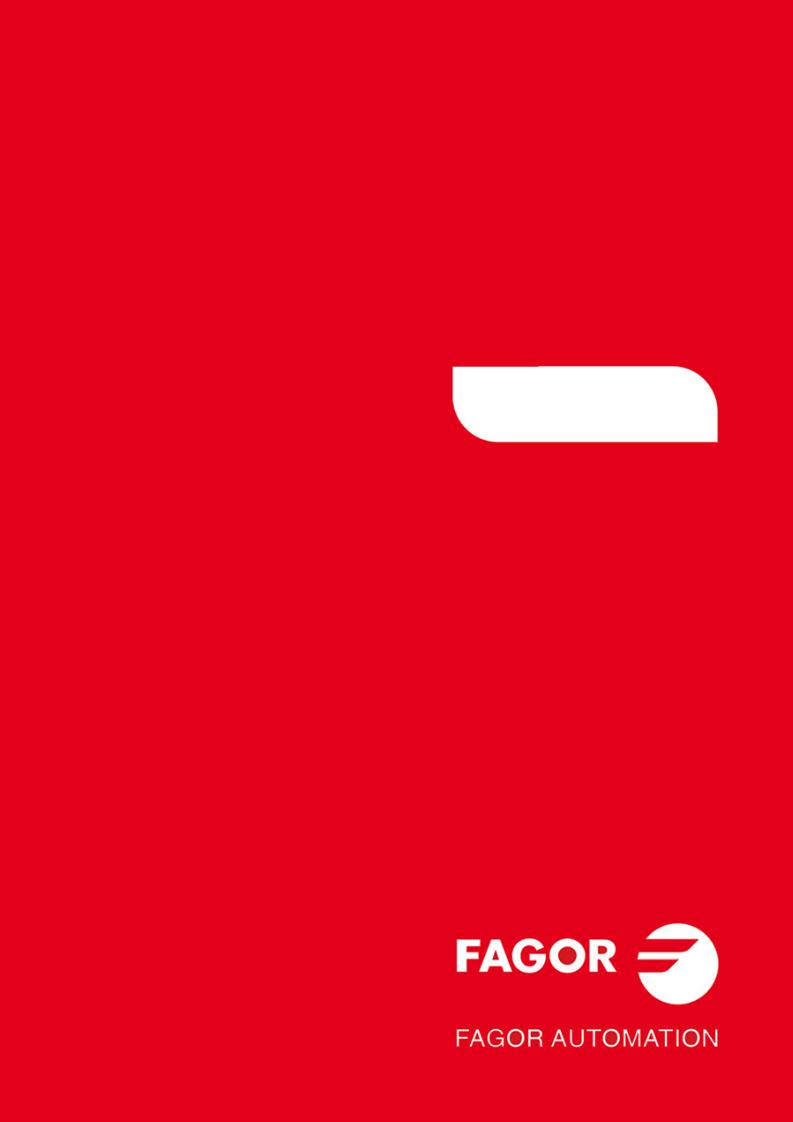
CNC |
8055 ·T· |
|
Programming manual |
|
Ref. 1310 |
|
Soft: V01.4x |

All rights reserved. No part of this documentation may be transmitted, transcribed, stored in a backup device or translated into another language without Fagor Automation’s consent. Unauthorized copying or distributing of this software is prohibited.
The information described in this manual may be subject to changes due to technical modifications. Fagor Automation reserves the right to change the contents of this manual without prior notice.
All the trade marks appearing in the manual belong to the corresponding owners. The use of these marks by third parties for their own purpose could violate the rights of the owners.
It is possible that CNC can execute more functions than those described in its associated documentation; however, Fagor Automation does not guarantee the validity of those applications. Therefore, except under the express permission from Fagor Automation, any CNC application that is not described in the documentation must be considered as "impossible". In any case, Fagor Automation shall not be held responsible for any personal injuries or physical damage caused or suffered by the CNC if it is used in any way other than as explained in the related documentation.
The content of this manual and its validity for the product described here has been verified. Even so, involuntary errors are possible, hence no absolute match is guaranteed. However, the contents of this document are regularly checked and updated implementing the necessary corrections in a later edition. We appreciate your suggestions for improvement.
The examples described in this manual are for learning purposes. Before using them in industrial applications, they must be properly adapted making sure that the safety regulations are fully met.
This product uses the following source code, subject to the terms of the GPL license. The applications busybox V0.60.2; dosfstools V2.9; linux-ftpd V0.17; ppp V2.4.0; utelnet V0.1.1. The librarygrx V2.4.4. The linux kernel V2.4.4. The linux boot ppcboot V1.1.3. If you would like to have a CD copy of this source code sent to you, send 10 Euros to Fagor Automation for shipping and handling.

Programming manual
I N D E X
|
About the product ......................................................................................................................... |
7 |
|
|
Declaration of conformity .............................................................................................................. |
9 |
|
|
Version history ............................................................................................................................ |
11 |
|
|
Safety conditions ........................................................................................................................ |
13 |
|
|
Warranty terms ........................................................................................................................... |
17 |
|
|
Material returning terms.............................................................................................................. |
19 |
|
|
Additional remarks ...................................................................................................................... |
21 |
|
|
Fagor documentation.................................................................................................................. |
23 |
|
CHAPTER 1 |
GENERAL CONCEPTS |
|
|
|
|
|
|
|
1.1 |
Part programs ................................................................................................................ |
26 |
|
1.1.1 |
Considerations regarding the Ethernet connection .................................................... |
28 |
|
1.2 |
DNC connection............................................................................................................. |
29 |
|
1.3 |
Communication protocol via DNC or peripheral device ................................................. |
30 |
CHAPTER 2 |
CREATING A PROGRAM |
|
|
|
|
|
|
|
2.1 |
Program structure at the CNC ....................................................................................... |
32 |
|
2.1.1 |
Block header .............................................................................................................. |
32 |
|
2.1.2 |
Program block ............................................................................................................ |
33 |
|
2.1.3 |
End of block ............................................................................................................... |
34 |
CHAPTER 3 |
AXES AND COORDINATE SYSTEMS |
|
|
|
|
|
|
|
3.1 |
Axis nomenclature ......................................................................................................... |
36 |
|
3.1.1 |
Axis selection ............................................................................................................. |
37 |
|
3.2 |
Plane selection (G16, G17, G18, G19) .......................................................................... |
38 |
|
3.3 |
Part dimensioning. Millimeters (G71) or inches (G70) ................................................... |
39 |
|
3.4 |
Absolute/incremental programming (G90, G91) ............................................................ |
40 |
|
3.5 |
Programming in radius or in diameters (G152, G151) ................................................... |
41 |
|
3.6 |
Coordinate programming ............................................................................................... |
42 |
|
3.6.1 |
Cartesian coordinates ................................................................................................ |
43 |
|
3.6.2 |
Polar coordinates ....................................................................................................... |
44 |
|
3.6.3 |
Angle and Cartesian coordinate................................................................................. |
46 |
|
3.7 |
Rotary axes.................................................................................................................... |
47 |
|
3.8 |
Work zones .................................................................................................................... |
48 |
|
3.8.1 |
Definition of the work zones ....................................................................................... |
48 |
|
3.8.2 |
Using the work zones................................................................................................. |
49 |
CHAPTER 4 |
REFERENCE SYSTEMS |
|
|
|
|
|
|
|
4.1 |
Reference points............................................................................................................ |
51 |
|
4.2 |
Machine reference (Home) search (G74) ...................................................................... |
52 |
|
4.3 |
Programming with respect to machine zero (G53) ........................................................ |
53 |
|
4.4 |
Coordinate preset and zero offsets................................................................................ |
54 |
|
4.4.1 |
Coordinate preset and S value limitation (G92) ......................................................... |
55 |
|
4.4.2 |
Zero offsets (G54..G59 and G159) ............................................................................ |
56 |
|
4.5 |
Polar origin preset (G93)................................................................................................ |
58 |
CHAPTER 5 |
ISO CODE PROGRAMMING |
|
|
|
|
|
|
|
5.1 |
Preparatory functions..................................................................................................... |
60 |
|
5.2 |
Feedrate F ..................................................................................................................... |
62 |
|
5.2.1 |
Feedrate in mm/min or inches/min (G94)................................................................... |
63 |
|
5.2.2 |
Feedrate in mm/rev.or inches/rev (G95) .................................................................... |
64 |
|
5.3 |
Spindle speed (S) .......................................................................................................... |
65 |
|
5.3.1 |
Constant surface speed (G96) ................................................................................... |
66 |
|
5.3.2 |
Spindle speed in rpm (G97) ....................................................................................... |
67 |
|
5.4 |
Spindle selection (G28, G29)......................................................................................... |
68 |
|
5.5 |
Synchronized spindles (G30, G77S, G78S) .................................................................. |
69 |
|
5.6 |
Tool number (T) and tool offset (D)................................................................................ |
70 |
CNC 8055
CNC 8055i
SOFT: V01.4X
·3·

CNC 8055
CNC 8055i
SOFT: V01.4X
|
|
|
Programming manual |
5.7 |
Auxiliary function (M) ..................................................................................................... |
72 |
|
5.7.1 |
M00. |
Program stop .................................................................................................... |
73 |
5.7.2 |
M01. |
Conditional program stop.................................................................................. |
73 |
5.7.3 |
M02. |
End of program ................................................................................................. |
73 |
5.7.4 |
M30. |
End of program with return to the first block ..................................................... |
73 |
5.7.5 |
M03, M4, M5. Spindle start and stop ......................................................................... |
73 |
|
5.7.6 |
M06. |
Tool change code ............................................................................................. |
75 |
5.7.7 |
M19. |
Spindle orientation ............................................................................................ |
75 |
5.7.8 |
M41, M42, M43, M44. Spindle gear change .............................................................. |
76 |
|
5.7.9 |
M45. |
Auxiliary spindle / Live tool................................................................................ |
77 |
CHAPTER 6 |
PATH CONTROL |
|
||
|
|
|
|
|
|
6.1 |
Rapid traverse (G00) ..................................................................................................... |
80 |
|
|
6.2 |
Linear interpolation (G01) .............................................................................................. |
81 |
|
|
6.3 |
Circular interpolation (G02, G03)................................................................................... |
82 |
|
|
6.4 |
Circular interpolation with absolute arc center coordinates (G06) ................................. |
86 |
|
|
6.5 |
Arc tangent to previous path (G08)................................................................................ |
87 |
|
|
6.6 |
Arc defined by three points (G09).................................................................................. |
88 |
|
|
6.7 |
Helical interpolation ....................................................................................................... |
89 |
|
|
6.8 |
Tangential entry at the beginning of a machining operation (G37)................................ |
90 |
|
|
6.9 |
Tangential exit at the end of a machining operator (G38) ............................................. |
91 |
|
|
6.10 |
Automatic radius blend (G36) ........................................................................................ |
92 |
|
|
6.11 |
Chamfer (G39)............................................................................................................... |
93 |
|
|
6.12 |
Threading (G33) ............................................................................................................ |
94 |
|
|
6.13 |
Withdrawal of axes when interrupting a threading operation (G233)............................. |
97 |
|
|
6.14 |
Variable pitch threads (G34).......................................................................................... |
99 |
|
|
6.15 |
Activates the C axis (G15). .......................................................................................... |
100 |
|
|
6.15.1 |
Machining on the side of the part............................................................................. |
101 |
|
|
6.15.2 |
Machining on the face of the part............................................................................. |
102 |
|
|
6.16 |
Move to hardstop (G52)............................................................................................... |
103 |
|
|
6.17 |
Feedrate "F" as an inverted function of time (G32)...................................................... |
104 |
|
|
6.18 |
Tangential control (G45) .............................................................................................. |
105 |
|
|
6.18.1 |
Considerations about the G45 function.................................................................... |
107 |
|
|
6.19 |
G145. Temporary cancellation of tangential control .................................................... |
108 |
|
CHAPTER 7 |
ADDITIONAL PREPARATORY FUNCTIONS |
|
|
|
|
|
|
|
7.1 |
Interruption of block preparation (G04)........................................................................ |
109 |
|
7.1.1 |
G04 K0: Block preparation interruption and coordinate update ............................... |
111 |
|
7.2 |
Dwell (G04 K) .............................................................................................................. |
112 |
|
7.3 |
Working with square (G07) and round (G05,G50) corners.......................................... |
113 |
|
7.3.1 |
G07 (square corner)................................................................................................. |
113 |
|
7.3.2 |
G05 (round corner) .................................................................................................. |
114 |
|
7.3.3 |
Controlled round corner (G50) ................................................................................. |
115 |
|
7.4 |
Look-ahead (G51)........................................................................................................ |
116 |
|
7.4.1 |
Advanced look-ahead algorithm (integrating Fagor filters) ...................................... |
118 |
|
7.4.2 |
Look-ahead operation with Fagor filters active ........................................................ |
119 |
|
7.5 |
Mirror image (G10, G11. G12, G13, G14) ................................................................... |
120 |
|
7.6 |
Scaling factor (G72)..................................................................................................... |
121 |
|
7.6.1 |
Scaling factor applied to all axes. ............................................................................ |
122 |
|
7.6.2 |
Scaling factor applied to one or more axes.............................................................. |
123 |
|
7.7 |
Electronic axis coupling/uncoupling............................................................................. |
125 |
|
7.7.1 |
Electronic axis coupling, slaving, (G77) ................................................................... |
126 |
|
7.7.2 |
Cancellation of the electronic axis coupling, slaving, (G78)..................................... |
127 |
|
7.8 |
Axes toggle G28-G29 .................................................................................................. |
128 |
CHAPTER 8 |
TOOL COMPENSATION |
|
|
|
|
|
|
|
8.1 |
Tool length compensation............................................................................................ |
129 |
|
8.2 |
Tool radius compensation............................................................................................ |
130 |
|
8.2.1 |
The location code of the tool (tool type)................................................................... |
131 |
|
8.2.2 |
Working without tool radius compensation .............................................................. |
134 |
|
8.2.3 |
Working with tool radius compensation ................................................................... |
135 |
|
8.2.4 |
Beginning of tool radius compensation (G41, G42) ................................................. |
136 |
|
8.2.5 |
Sections of tool radius compensation ...................................................................... |
139 |
|
8.2.6 |
Cancellation of tool radius compensation (G40) ...................................................... |
140 |
|
8.2.7 |
Temporary cancellation of tool compensation with G00 .......................................... |
144 |
|
8.2.8 |
Change of type of tool radius compensation while machining ................................. |
146 |
|
8.2.9 |
Tool compensation in any plane .............................................................................. |
147 |
|
8.3 |
Collision detection (G41 N, G42 N) ............................................................................. |
148 |
·4·

Programming manual |
|
|
|
||
CHAPTER 9 |
CANNED CYCLES |
|
|||
|
|
|
|
|
|
|
9.1 |
G66. |
Pattern repeat cycle canned cycle ...................................................................... |
150 |
|
|
9.1.1 |
|
Basic operation ........................................................................................................ |
153 |
|
|
9.1.2 |
|
Profile programming syntax ..................................................................................... |
155 |
|
|
9.2 |
G68. |
X axis roughing canned cycle ............................................................................. |
156 |
|
|
9.2.1 |
|
Basic operation ........................................................................................................ |
159 |
|
|
9.2.2 |
|
Profile programming syntax ..................................................................................... |
162 |
|
|
9.3 |
G69. |
Z axis roughing canned cycle.............................................................................. |
163 |
|
|
9.3.1 |
|
Basic operation ........................................................................................................ |
166 |
|
|
9.3.2 |
|
Profile programming syntax ..................................................................................... |
169 |
|
|
9.4 |
G81. |
Turning canned cycle for straight sections.......................................................... |
170 |
|
|
9.4.1 |
|
Basic operation ........................................................................................................ |
172 |
|
|
9.5 |
G82. |
Facing canned cycle for straight sections ........................................................... |
174 |
|
|
9.5.1 |
|
Basic operation ........................................................................................................ |
176 |
|
|
9.6 |
G83. |
Axial drilling and tapping canned cycle ............................................................... |
178 |
|
|
9.6.1 |
|
Basic operation ........................................................................................................ |
180 |
|
|
9.7 |
G84. |
Turning canned cycle for curved sections........................................................... |
181 |
|
|
9.7.1 |
|
Basic operation ........................................................................................................ |
183 |
|
|
9.8 |
G85. |
Facing canned cycle for curved sections ............................................................ |
185 |
|
|
9.8.1 |
|
Basic operation ........................................................................................................ |
187 |
|
|
9.9 |
G86. |
Longitudinal threading canned cycle................................................................... |
189 |
|
|
9.9.1 |
|
Basic operation ........................................................................................................ |
194 |
|
|
9.10 |
G87. |
Face threading canned cycle .............................................................................. |
195 |
|
|
9.10.1 |
Basic operation ........................................................................................................ |
201 |
||
|
9.11 |
G88. |
X axis grooving canned cycle.............................................................................. |
202 |
|
|
9.11.1 |
Basic operation ........................................................................................................ |
203 |
||
|
9.12 |
G89. |
Z axis grooving canned cycle.............................................................................. |
204 |
|
|
9.12.1 |
Basic operation ........................................................................................................ |
205 |
||
|
9.13 |
G60. |
Axial drilling / tapping (on the face) ..................................................................... |
206 |
|
|
9.13.1 |
Basic operation ........................................................................................................ |
208 |
||
|
9.14 |
G61. |
Radial drilling/ tapping (on the side of the part)................................................... |
210 |
|
|
9.14.1 |
Basic operation ........................................................................................................ |
212 |
||
|
9.15 |
G62. |
Slot milling canned cycle on the side of the part ................................................. |
214 |
|
|
9.15.1 |
Basic operation ........................................................................................................ |
216 |
||
|
9.16 |
G63. |
Slot milling canned cycle on the face of the part................................................. |
217 |
|
|
9.17 |
Basic operation ............................................................................................................ |
219 |
||
CHAPTER 10 |
PROBING |
|
|
|
|
|
|
|
10.1 |
Probing (G75, G76)...................................................................................................... |
222 |
|
10.2 |
Probing canned cycles................................................................................................. |
223 |
|
10.3 |
PROBE 1. Tool calibration canned cycle ..................................................................... |
224 |
|
10.3.1 |
Basic operation ........................................................................................................ |
227 |
|
10.4 |
PROBE 2. Probe calibration canned cycle. ................................................................. |
230 |
|
10.4.1 |
Basic operation ........................................................................................................ |
231 |
|
10.5 |
PROBE 3. Canned cycle for part measuring and tool correction on the X axis ........... |
233 |
|
10.5.1 |
Basic operation ........................................................................................................ |
234 |
|
10.6 |
PROBE 4. Canned cycle for part measuring and tool correction on the Z axis ........... |
235 |
|
10.6.1 |
Basic operation ........................................................................................................ |
236 |
CHAPTER 11 |
HIGH-LEVEL LANGUAGE PROGRAMMING |
|
|
|
|
|
|
|
11.1 |
Lexical description ....................................................................................................... |
237 |
|
11.2 |
Variables ...................................................................................................................... |
239 |
|
11.2.1 |
General purpose parameters or variables................................................................ |
240 |
|
11.2.2 |
Variables associated with tools. ............................................................................... |
242 |
|
11.2.3 |
Variables associated with zero offsets. .................................................................... |
245 |
|
11.2.4 |
Variables associated with machine parameters....................................................... |
246 |
|
11.2.5 |
Variables associated with work zones ..................................................................... |
247 |
|
11.2.6 |
Variables associated with feedrates......................................................................... |
249 |
|
11.2.7 |
Variables associated with coordinates ..................................................................... |
251 |
|
11.2.8 |
Variables associated with electronic handwheels .................................................... |
253 |
|
11.2.9 |
Variables associated with feedback ......................................................................... |
255 |
|
11.2.10 |
Variables associated with the main spindle ............................................................. |
256 |
|
11.2.11 |
Variables associated with the second spindle.......................................................... |
259 |
|
11.2.12 |
Variables associated with the live tool ..................................................................... |
262 |
|
11.2.13 |
PLC related variables............................................................................................... |
263 |
|
11.2.14 |
Variables associated with local parameters ............................................................. |
265 |
|
11.2.15 |
Sercos variables....................................................................................................... |
266 |
|
11.2.16 |
Software & hardware configuration variables........................................................... |
267 |
|
11.2.17 |
Variables associated with telediagnosis................................................................... |
270 |
|
11.2.18 |
Operating-mode related variables............................................................................ |
273 |
|
11.2.19 |
Other variables......................................................................................................... |
276 |
|
11.3 |
Constants..................................................................................................................... |
281 |
CNC 8055
CNC 8055i
SOFT: V01.4X
·5·

|
|
Programming manual |
11.4 |
Operators..................................................................................................................... |
282 |
11.5 |
Expressions ................................................................................................................. |
284 |
11.5.1 |
Arithmetic expressions............................................................................................. |
284 |
11.5.2 |
Relational expressions............................................................................................. |
285 |
CHAPTER 12 |
PROGRAM CONTROL INSTRUCTIONS |
|
|
|
|
|
|
|
12.1 |
Assignment instructions............................................................................................... |
288 |
|
12.2 |
Display instructions...................................................................................................... |
289 |
|
12.3 |
Enable-disable instructions.......................................................................................... |
290 |
|
12.4 |
Flow control instructions .............................................................................................. |
291 |
|
12.5 |
Subroutine instructions ................................................................................................ |
293 |
|
12.6 |
Probe related instructions ............................................................................................ |
297 |
|
12.7 |
Interruption-subroutine instructions ............................................................................. |
298 |
|
12.8 |
Program instructions.................................................................................................... |
299 |
|
12.9 |
Screen customizing instructions .................................................................................. |
302 |
CHAPTER 13 |
ANGULAR TRANSFORMATION OF AN INCLINE AXIS |
|
|
|
|
|
|
|
13.1 |
Turning angular transformation on and off................................................................... |
309 |
|
13.2 |
Freezing the angular transformation............................................................................ |
310 |
APPENDIX |
|
|
|
|
|
|
|
|
A |
ISO code programming................................................................................................ |
313 |
|
B |
Program control instructions ........................................................................................ |
315 |
|
C |
Summary of internal CNC variables. ........................................................................... |
319 |
|
D |
Key code...................................................................................................................... |
327 |
|
E |
Programming assistance screens of the system. ........................................................ |
337 |
|
F |
Maintenance ................................................................................................................ |
341 |
CNC 8055
CNC 8055i
SOFT: V01.4X
·6·

ABOUT THE PRODUCT
BASIC CHARACTERISTICS OF THE DIFFERENT MODELS.
|
|
|
|
|
|
|
8055 FL |
8055 Power |
|
8055i FL |
8055i Power |
|
8055i FL EN |
|
|
|
|
Built-in |
8055i FL |
8055i Power |
|
8055i FL EN |
|
|
|
|
Enclosure |
8055 FL |
8055 Power |
|
|
|
USB |
Standard |
Standard |
|
|
|
Block processing time |
3.5 ms |
0.9 ms |
|
|
|
RAM memory |
1Mb |
1 Mb |
|
|
|
Software for 7 axes |
----- |
Option |
|
|
|
TCP transformation |
----- |
Option |
|
|
|
C axis (Lathe) |
----- |
Option |
|
|
|
Y axis (Lathe) |
----- |
Option |
|
|
|
Look-ahead |
100 blocks |
200 blocks |
|
|
|
Flash Memory 512Mb / 2Gb |
Option |
Option |
|
512Mb on the EN model |
|
|
|
|
|
|
|
|
|
|
HARDWARE OPTIONS OF THE 8055I CNC
|
|
|
|
|
|
|
|
|
Analog |
Digital |
Engraving |
|
|
|
|
Ethernet |
Option |
Option |
Option |
|
|
|
|
RS-232 serial line |
Standard |
Standard |
Standard |
|
|
|
|
16 digital inputs and 8 outputs (I1 to I16 and O1 to O8) |
Standard |
Standard |
Standard |
|
|
|
|
Another 40 digital inputs and 24 outputs (I65 to I104 and O33 to O56) |
Option |
Option |
Option |
|
|
|
|
Probe inputs |
Standard |
Standard |
Standard |
|
|
|
|
Spindle (feedback input and analog output) |
Standard |
Standard |
Standard |
|
|
|
|
Electronic handwheels |
Standard |
Standard |
Standard |
|
|
|
|
4 axes (feedback and velocity command) |
Option |
Option |
- - - |
|
|
|
|
Remote CAN modules, for digital I/O expansion (RIO). |
Option |
Option |
- - - |
|
|
|
|
Sercos servo drive system for Fagor servo drive connection. |
- - - |
Option |
- - - |
|
|
|
|
CAN servo drive system for Fagor servo drive connection. |
- - - |
Option |
- - - |
|
|
|
|
Before start-up, verify that the machine that integrates this CNC meets the 89/392/CEE Directive.
CNC 8055
CNC 8055i
·7·
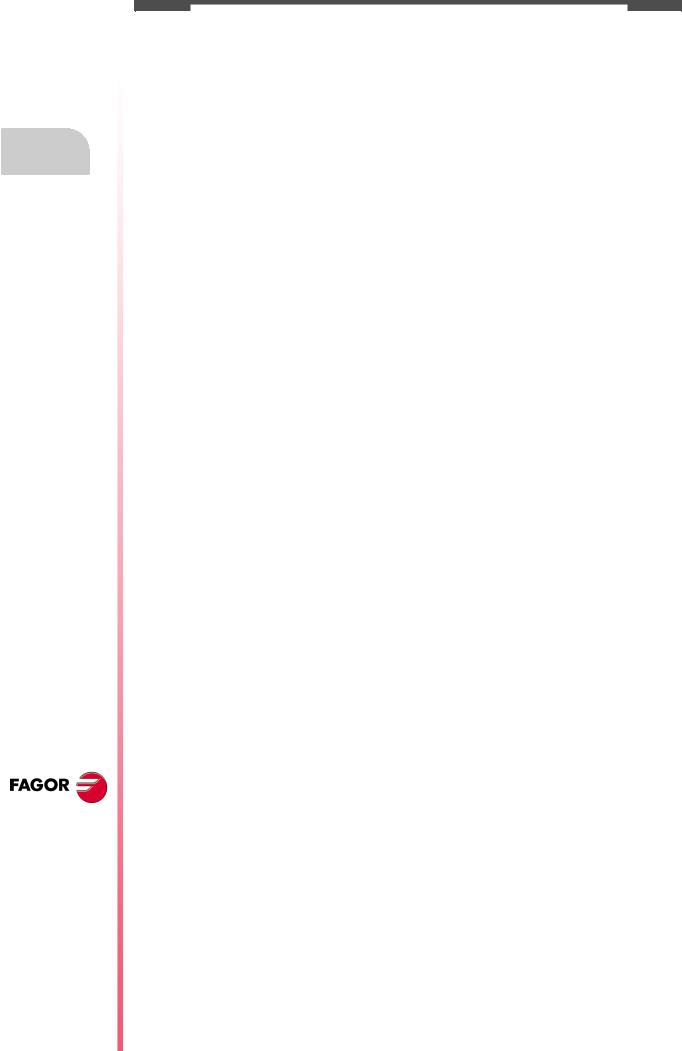
About the product
CNC 8055
CNC 8055i
SOFTWARE OPTIONS OF THE 8055 AND 8055I CNCS.
|
|
|
|
|
|
|
|
|
|
|
|
|
|
|
|
|
|
|
|
|
|
Model |
|
|
|
|
|
|
|
|
|
|
|
|
|
|
GP |
M |
MC |
MCO |
EN |
T |
TC |
TCO |
|
|
|
|
|
|
|
|
|
Number of axes with standard software |
4 |
4 |
4 |
4 |
3 |
2 |
2 |
2 |
|
|
|
|
|
|
|
|
|
Number of axes with optional software |
7 |
7 |
7 |
7 |
----- |
4 or 7 |
4 or 7 |
4 or 7 |
|
|
|
|
|
|
|
|
|
Electronic threading |
----- |
Stand. |
Stand. |
Stand. |
Stand. |
Stand. |
Stand. |
Stand. |
|
|
|
|
|
|
|
|
|
Tool magazine management: |
----- |
Stand. |
Stand. |
Stand. |
----- |
Stand. |
Stand. |
Stand. |
|
|
|
|
|
|
|
|
|
Machining canned cycles |
----- |
Stand. |
Stand. |
----- |
Stand. |
Stand. |
Stand. |
----- |
|
|
|
|
|
|
|
|
|
Multiple machining |
----- |
Stand. |
Stand. |
----- |
Stand. |
----- |
----- |
----- |
|
|
|
|
|
|
|
|
|
Solid graphics |
----- |
Stand. |
Stand. |
Stand. |
----- |
Stand. |
Stand. |
Stand. |
|
|
|
|
|
|
|
|
|
Rigid tapping |
----- |
Stand. |
Stand. |
Stand. |
Stand. |
Stand. |
Stand. |
Stand. |
|
|
|
|
|
|
|
|
|
Tool live monitoring |
----- |
Opt. |
Opt. |
Opt. |
Stand. |
Opt. |
Opt. |
Opt. |
|
|
|
|
|
|
|
|
|
Probing canned cycles |
----- |
Opt. |
Opt. |
Opt. |
Stand. |
Opt. |
Opt. |
Opt. |
|
|
|
|
|
|
|
|
|
DNC |
Stand. |
Stand. |
Stand. |
Stand. |
Stand. |
Stand. |
Stand. |
Stand. |
|
|
|
|
|
|
|
|
|
COCOM version |
Opt. |
Opt. |
Opt. |
Opt. |
----- |
Opt. |
Opt. |
Opt. |
|
|
|
|
|
|
|
|
|
Profile editor |
Stand. |
Stand. |
Stand. |
Stand. |
----- |
Stand. |
Stand. |
Stand. |
|
|
|
|
|
|
|
|
|
Tool radius compensation |
Stand. |
Stand. |
Stand. |
Stand. |
Stand. |
Stand. |
Stand. |
Stand. |
|
|
|
|
|
|
|
|
|
Tangential control |
Opt. |
Opt. |
Opt. |
Opt. |
----- |
Opt. |
Opt. |
Opt. |
|
|
|
|
|
|
|
|
|
Retracing |
----- |
Opt. |
Opt. |
Opt. |
Stand. |
Opt. |
Opt. |
Opt. |
|
|
|
|
|
|
|
|
|
Setup assistance |
Stand. |
Stand. |
Stand. |
Stand. |
Stand. |
Stand. |
Stand. |
Stand. |
|
|
|
|
|
|
|
|
|
Irregular pockets with islands |
----- |
Stand. |
Stand. |
Stand. |
----- |
----- |
----- |
----- |
|
|
|
|
|
|
|
|
|
TCP transformation |
----- |
Opt. |
Opt. |
Opt. |
----- |
----- |
----- |
----- |
|
|
|
|
|
|
|
|
|
C axis (on Lathe) |
----- |
----- |
----- |
----- |
----- |
Opt. |
Opt. |
Opt. |
|
|
|
|
|
|
|
|
|
Y axis (on Lathe) |
----- |
----- |
----- |
----- |
----- |
Opt. |
Opt. |
Opt. |
|
|
|
|
|
|
|
|
|
Telediagnosis |
Opt. |
Opt. |
Opt. |
Opt. |
Stand. |
Opt. |
Opt. |
Opt. |
|
|
|
|
|
|
|
|
|
·8·
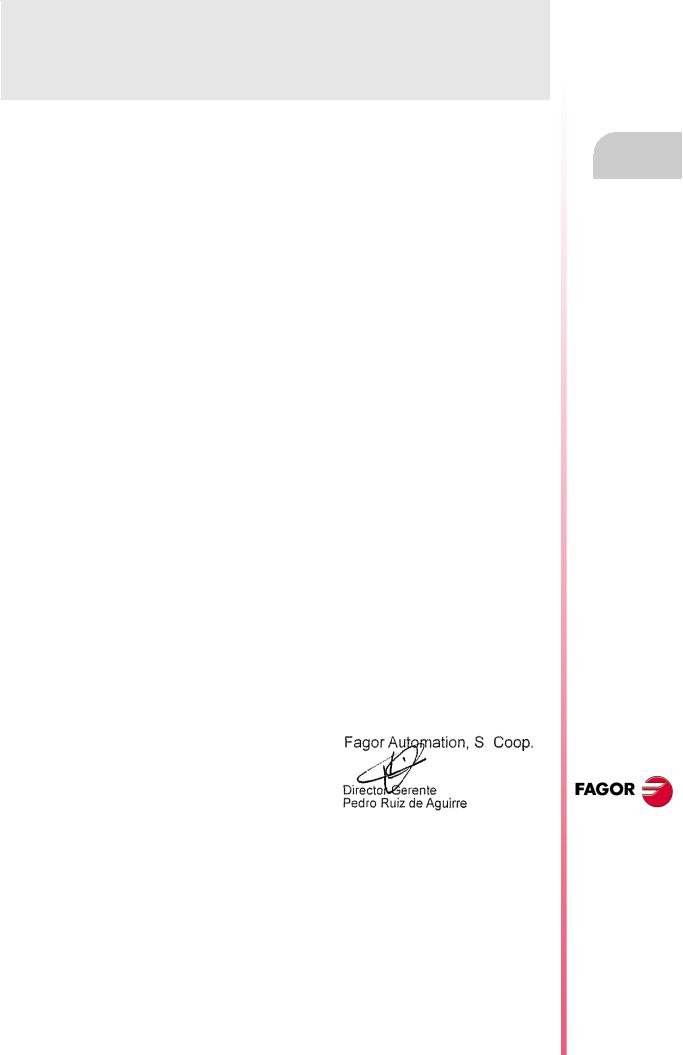
DECLARATION OF CONFORMITY
The manufacturer:
Fagor Automation S. Coop.
Barrio de San Andrés Nº 19, C.P. 20500, Mondragón -Guipúzcoa- (SPAIN).
Declares:
Under their responsibility that the product:
8055 / 8055i CNC
Consisting of the following modules and accessories:
MONITOR-8055, MONITOR-55-11-USB
OP-8055
KS 50/55, KB-40/55-ALFA, DVD AMPLI 8055
PSB-8055
CPU-KEY CF 8055 FL LARGE, CPU-KEY CF 8055 Power LARGE
AXES 8055 VPP
I/O 8055, COVER 8055, SERCOS 8055
Remote modules RIO
CNC 8055i FL, CNC 8055i Power
ANALOG 8055i-B, 40I/24O-8055i-B, ANALOG+40I/24O-B, COVER ANA+I/O-8055i-B
ETHERNET-CAN-SERCOS, ETHERNET-CAN-CAN AXES, ETHERNET-CAN AXES
Note. Some additional characters may follow the references mentioned above. They all comply with the directives listed. However, check that that's the case by checking the label of the unit itself.
Referred to by this declaration with following directives:
Low voltage regulations.
EN 60204-1: 2006 Electrical equipment on machines — Part 1. General requirements.
Regulation on electromagnetic compatibility.
EN 61131-2: 2007 PLC — Part 2. Requirements and equipment tests.
As instructed by the European Community Directives 2006/95/EEC on Low Voltage and 2004/108/EC on Electromagnetic Compatibility and its updates.
In Mondragón, July 27th, 2010.
CNC 8055
CNC 8055i
·9·

VERSION HISTORY
Here is a list of the features added in each software version and the manuals that describe them.
The version history uses the following abbreviations: |
|
INST |
Installation manual |
PRG |
Programming manual |
OPT |
Operating manual |
OPT-MC |
Operating manual for the MC option. |
OPT-TC |
Operating manual for the TC option. |
OPT-CO |
Manual of the CO manual |
Software V01.00 |
October 2010 |
First version. |
|
|
|
Software V01.20 |
April 2011 |
|
|
List of features |
Manual |
Open communication. |
INST |
Improvements to Look Ahead machining. |
INST |
|
|
Blocks with helical interpolation in G51. |
PRG |
|
|
G84. Tapping with relief. |
PRG |
|
|
|
|
Software V01.08 |
August 2011 |
|
|
List of features |
Manual |
S.m.p. OPLDECTI (P86). |
INST |
|
|
|
|
Software V01.30 |
September 2011 |
|
|
List of features |
Manual |
Gear ratio management on Sercos spindles |
INST |
Improved feedrate limit management (FLIMIT). |
INST |
|
|
New type of penetration in lathe type threading cycles. |
PRG |
|
|
Improved lathe type thread repair. Partial repair. |
PRG |
|
|
MC option: Rigid tapping with relief. |
OPT-MC |
|
|
TC option: New type of penetration in threading cycles. |
OPT-TC |
|
|
TC option: Improved thread repair. Partial and multi-entry (start) thread repair. |
OPT-TC |
|
|
TC option: Zig-zag entry to the groove at the starting point of the groove. |
OPT-TC |
|
|
CNC 8055
CNC 8055i
·11·

Software V01.31 |
October 2011 |
|
|
List of features |
Manual |
CNC 8055 FL Engraving model |
INST / OPT/ PRG |
|
Software V01.40 |
January 2012 |
|
history |
|
|
|
List of features |
Manual |
||
|
|||
|
Execution of M3, M4 and M5 using PLC marks |
INST / PRG |
|
Version |
Values 12 and 43 of variable OPMODE in conversational work mode. |
INST |
|
|
|
||
|
|
CNC 8055
CNC 8055i
·12·
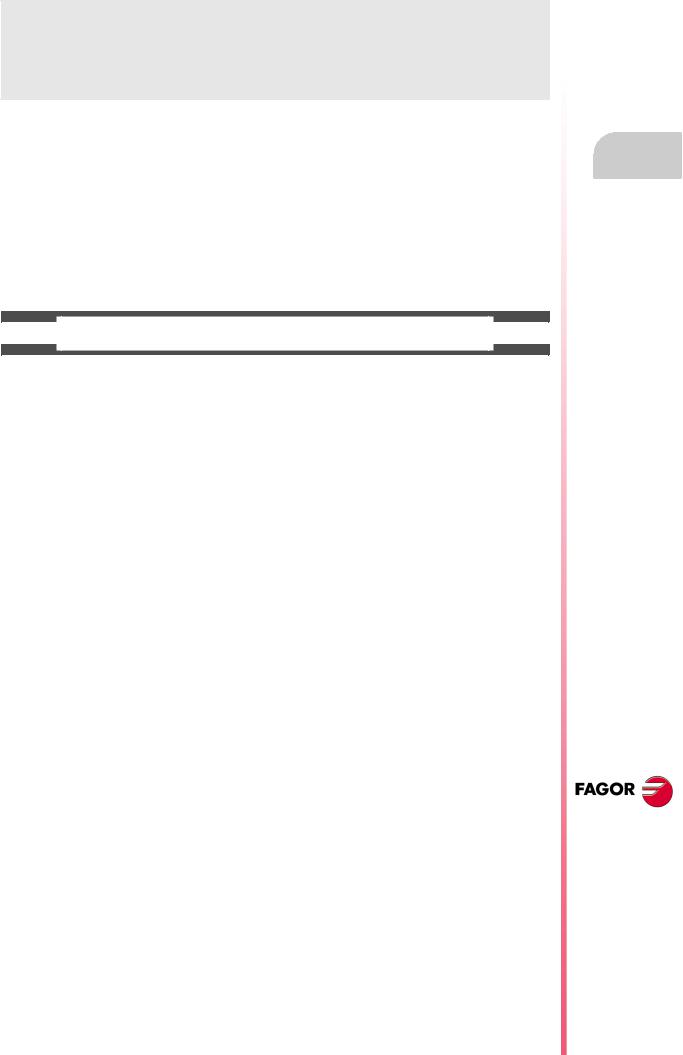
SAFETY CONDITIONS
Read the following safety measures in order to prevent harming people or damage to this product and those products connected to it.
This unit may only be repaired by authorized personnel at Fagor Automation.
Fagor Automation shall not be held responsible of any physical damage or defective unit resulting from not complying with these basic safety regulations.
PRECAUTIONS AGAINST PERSONAL DAMAGE
•Interconnection of modules.
Use the connection cables provided with the unit.
•Use proper Mains AC power cables
To avoid risks, use only the Mains AC cables recommended for this unit.
•Avoid electrical overloads.
In order to avoid electrical discharges and fire hazards, do not apply electrical voltage outside the range selected on the rear panel of the central unit.
•Ground connection.
In order to avoid electrical discharges, connect the ground terminals of all the modules to the main ground terminal. Before connecting the inputs and outputs of this unit, make sure that all the grounding connections are properly made.
•Before powering the unit up, make sure that it is connected to ground.
In order to avoid electrical discharges, make sure that all the grounding connections are properly made.
•Do not work in humid environments.
In order to avoid electrical discharges, always work under 90% of relative humidity (non-condensing) and 45 ºC (113º F).
•Do not work in explosive environments.
In order to avoid risks or damages, do no work in explosive environments.
CNC 8055
CNC 8055i
·13·
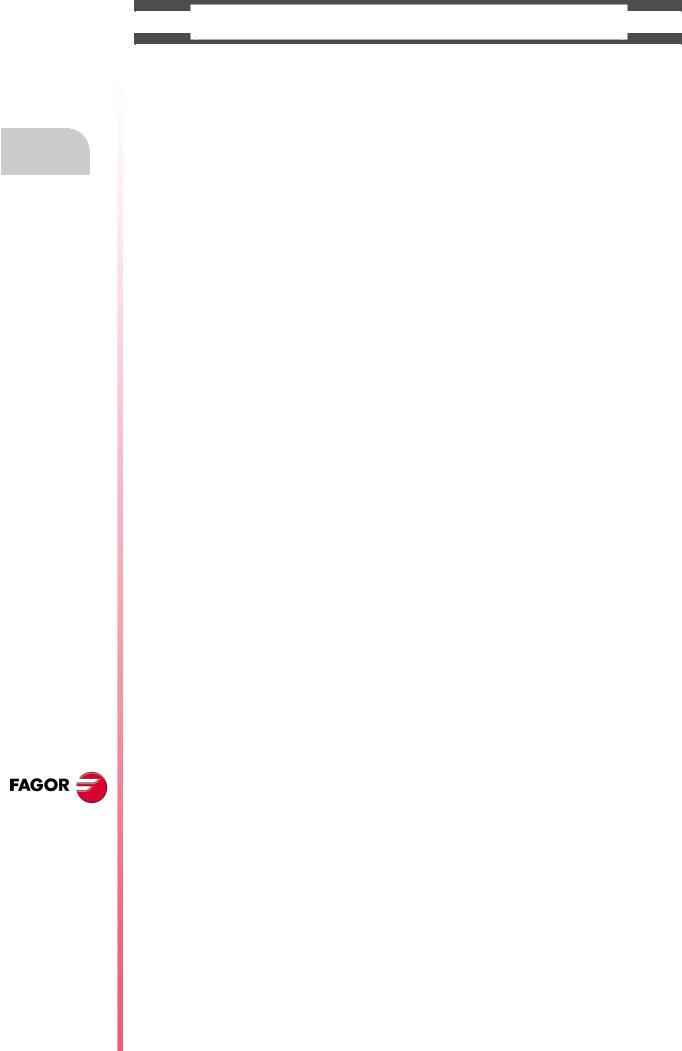
Safety conditions
CNC 8055
CNC 8055i
PRECAUTIONS AGAINST PRODUCT DAMAGE
•Working environment.
This unit is ready to be used in industrial environments complying with the directives and regulations effective in the European Community.
Fagor Automation shall not be held responsible for any damage suffered or caused when installed in other environments (residential or homes).
•Install this unit in the proper place.
It is recommended, whenever possible, to install the CNC away from coolants, chemical product, blows, etc. that could damage it.
This unit complies with the European directives on electromagnetic compatibility. Nevertheless, it is recommended to keep it away from sources of electromagnetic disturbance such as:
Powerful loads connected to the same AC power line as this equipment.
Nearby portable transmitters (Radio-telephones, Ham radio transmitters).
Nearby radio/TV transmitters.
Nearby arc welding machines.
Nearby High Voltage power lines.
Etc.
•Enclosures.
The manufacturer is responsible of assuring that the enclosure involving the equipment meets all the currently effective directives of the European Community.
•Avoid disturbances coming from the machine tool.
The machine-tool must have all the interference generating elements (relay coils, contactors, motors, etc.) uncoupled.
DC relay coils. Diode type 1N4000.
AC relay coils. RC connected as close to the coils as possible with approximate values of R=2201 W y C=0,2 µF / 600 V.
AC motors. RC connected between phases, with values of R=300 / 6 W y C=0,47 µF / 600 V.
•Use the proper power supply.
Use an external regulated 24 Vdc power supply for the inputs and outputs.
•Grounding of the power supply.
The zero volt point of the external power supply must be connected to the main ground point of the machine.
•Analog inputs and outputs connection.
It is recommended to connect them using shielded cables and connecting their shields (mesh) to the corresponding pin.
•Ambient conditions.
The working temperature must be between +5 ºC and +40 ºC (41ºF and 104º F) The storage temperature must be between -25 ºC and +70 ºC. (-13 ºF and 158 ºF)
•Monitor enclosure (CNC 8055) or central unit ( CNC 8055i)
Guarantee the required gaps between the monitor or the central unit and each wall of the enclosure. Use a DC fan to improve enclosure ventilation.
•Power switch.
This power switch must be mounted in such a way that it is easily accessed and at a distance between 0.7 meters (27.5 inches) and 1.7 meters (5.5ft) off the floor.
·14·
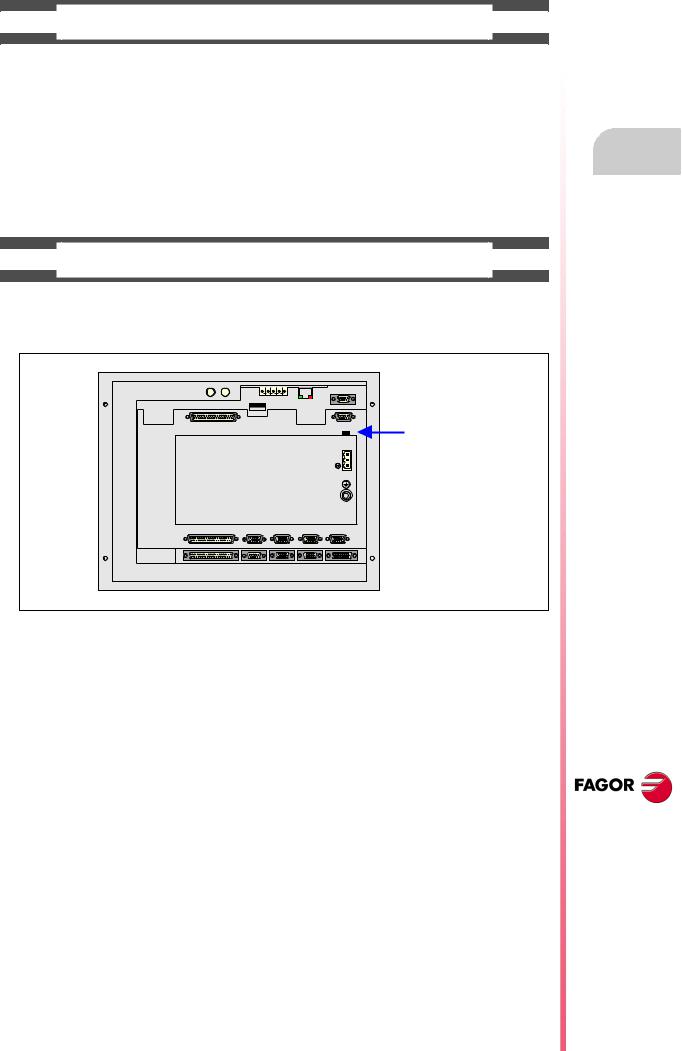
PROTECTIONS OF THE UNIT ITSELF (8055)
•"Axes" and "Inputs-Outputs" modules.
All the digital inputs and outputs have galvanic isolation via optocouplers between the CNC circuitry and the outside.
They are protected by an external fast fuse (F) of 3.15 A 250V against overvoltage of the external power supply (over 33 Vdc) and against reverse connection of the power supply.
•Monitor.
The type of protection fuse depends on the type of monitor. See identification label of the unit itself.
PROTECTIONS OF THE UNIT ITSELF (8055I)
•Central Unit.
It has a 4 A 250V external fast fuse (F).
OUT IN
X1 |
X7 |
X8 |
FUSE |
|
|
FUSIBLE |
+24V
0V
X9 |
X10 |
X11 |
X12 |
X13 |
X2 |
X3 |
X4 |
X5 |
X6 |
Safety conditions
•Inputs-Outputs.
All the digital inputs and outputs have galvanic isolation via optocouplers between the CNC circuitry and the outside.
CNC 8055
CNC 8055i
·15·
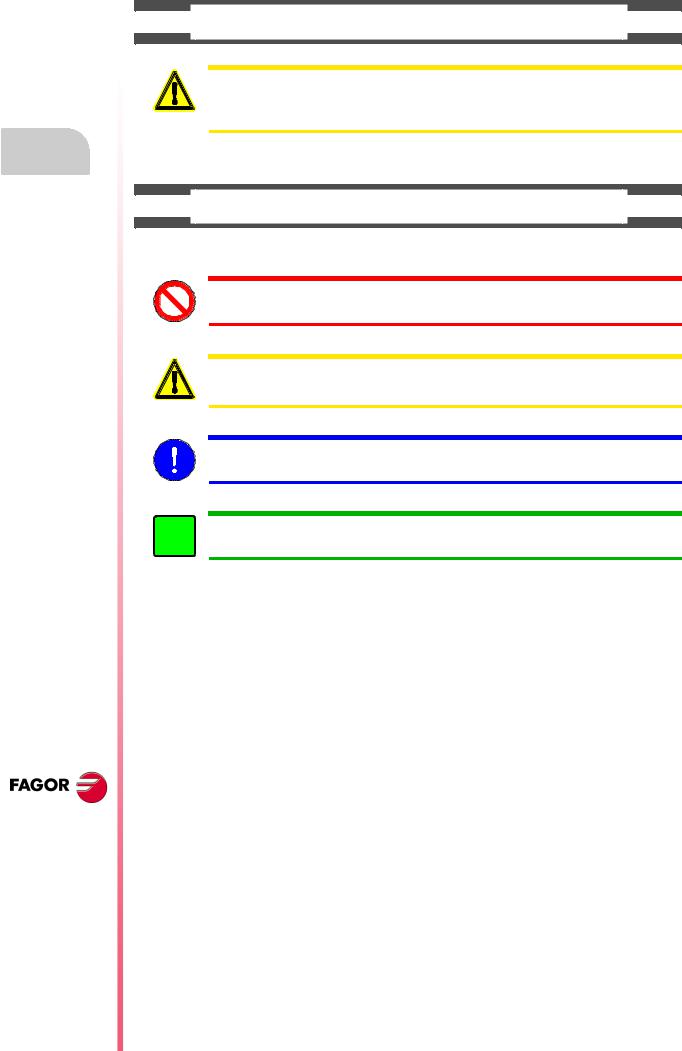
Safety conditions
CNC 8055
CNC 8055i
PRECAUTIONS DURING REPAIR
Do not get into the inside of the unit. Only personnel authorized by Fagor Automation may manipulate the inside of this unit.
Do not handle the connectors with the unit connected to main AC power. Before manipulating the connectors (inputs/outputs, feedback, etc.) make sure that the unit is not connected to AC power.
SAFETY SYMBOLS
• Symbols which may appear on the manual.
Symbol for danger or prohibition.
It indicates actions or operations that may cause damage to people or to units.
Warning symbol.
It indicates situations that may be caused by certain operations and the actions to be taken to prevent them.
Obligation symbol.
It indicates actions and operations that must be carried out.
i |
Information symbol. |
It indicates notes, warnings and advises. |
·16·
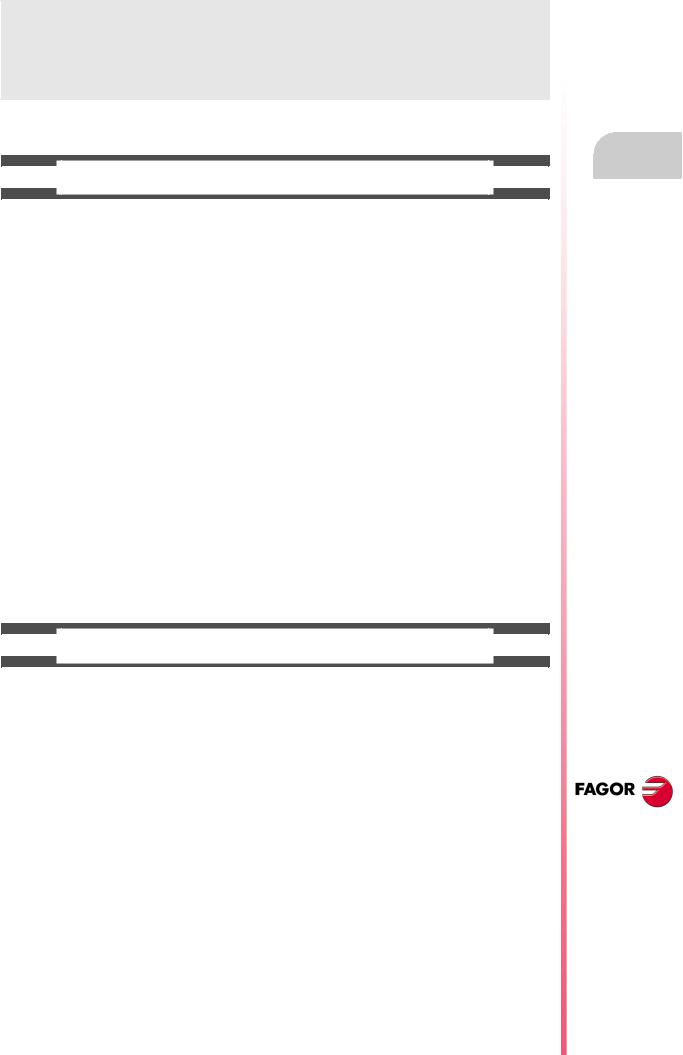
WARRANTY TERMS
INITIAL WARRANTY
All products manufactured or marketed by FAGOR carry a 12-month warranty for the end user which could be controlled by the our service network by means of the warranty control system established by FAGOR for this purpose.
In order to prevent the possibility of having the time period from the time a product leaves our warehouse until the end user actually receives it run against this 12-month warranty, FAGOR has set up a warranty control system based on having the manufacturer or agent inform FAGOR of the destination, identification and on-machine installation date, by filling out the document accompanying each FAGOR product in the warranty envelope. This system, besides assuring a full year of warranty to the end user, enables our service network to know about FAGOR equipment coming from other countries into their area of responsibility.
The warranty starting date will be the one appearing as the installation date on the above mentioned document. FAGOR offers the manufacturer or agent 12 months to sell and install the product. This means that the warranty starting date may be up to one year after the product has left our warehouse so long as the warranty control sheet has been sent back to us. This translates into the extension of warranty period to two years since the product left our warehouse. If this sheet has not been sent to us, the warranty period ends 15 months from when the product left our warehouse.
This warranty covers all costs of material and labour involved in repairs at FAGOR carried out to correct malfunctions in the equipment. FAGOR undertakes to repair or replace their products within the period from the moment manufacture begins until 8 years after the date on which it disappears from the catalog.
FAGOR has exclusive competence in deciding whether the repair enters within the term defined as the warranty period.
EXCLUDING CLAUSES
Repairs will be carried out on our premises. Therefore, all expenses incurred as a result of trips made by technical personnel to carry out equipment repairs, despite these being within the above-mentioned period of warranty, are not covered by the warranty.
Said warranty will be applied whenever the equipment has been installed in accordance with instructions, has not be mistreated, has not been damaged by accident or by negligence and has not been tampered with by personnel not authorized by FAGOR. If, once servicing or repairs have been made, the cause of the malfunction cannot be attributed to said elements, the customer is obliged to cover the expenses incurred, in accordance with the tariffs in force.
Other warranties, implicit or explicit, are not covered and FAGOR AUTOMATION cannot be held responsible for other damages which may occur.
CNC 8055
CNC 8055i
·17·
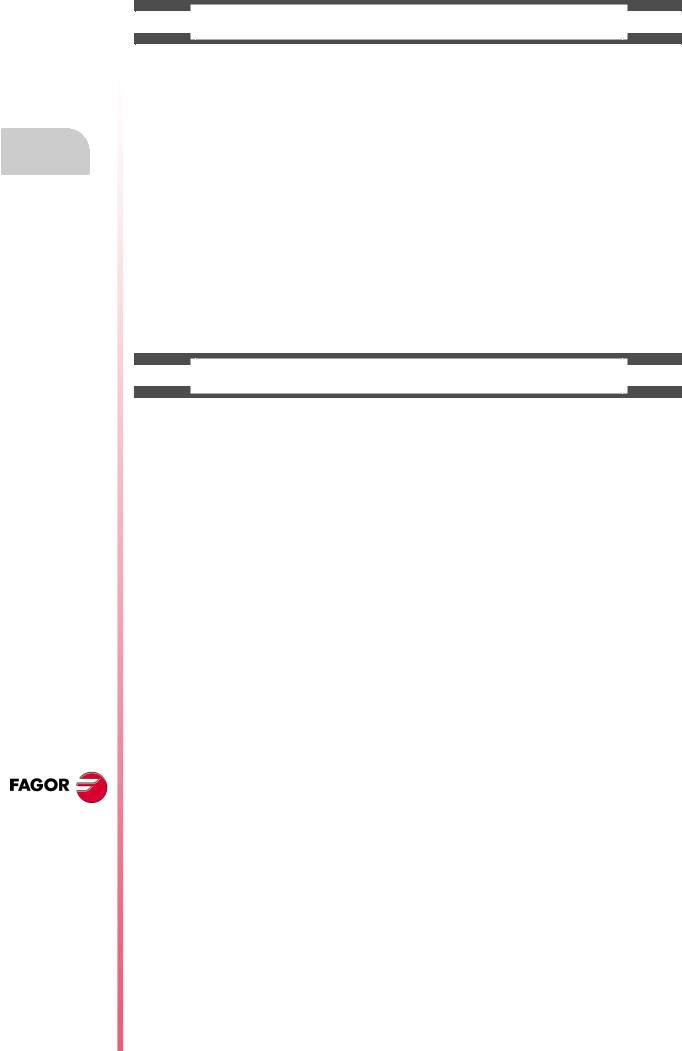
Warranty terms
CNC 8055
CNC 8055i
WARRANTY ON REPAIRS
In a similar way to the initial warranty, FAGOR offers a warranty on standard repairs according to the following conditions:
PERIOD |
12 months. |
|
|
CONCEPT |
Covers parts and labor for repairs (or replacements) at the network's own |
|
facilities. |
|
|
EXCLUDING CLAUSES |
The same as those applied regarding the chapter on initial warranty. |
|
If the repair is carried out within the warranty period, the warranty extension |
|
has no effect. |
|
|
When the customer does not choose the standard repair and just the faulty material has been replaced, the warranty will cover just the replaced parts or components within 12 months.
For sold parts the warranty is 12 moths length.
MAINTENANCE CONTRACTS
The SERVICE CONTRACT is available for the distributor or manufacturer who buys and installs our CNC systems.
·18·
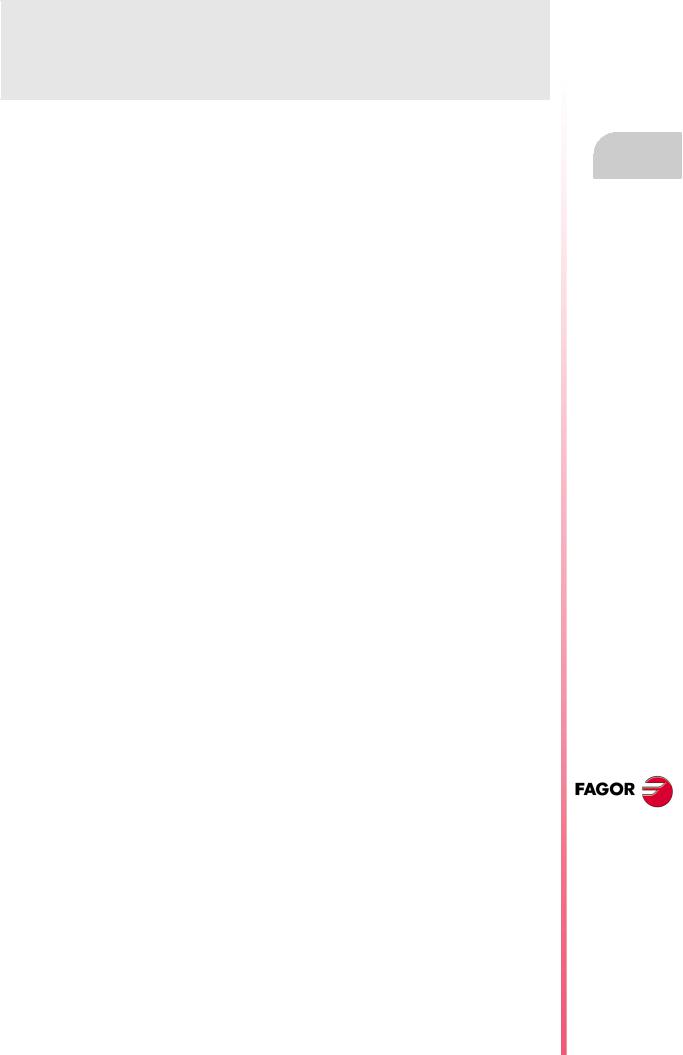
MATERIAL RETURNING TERMS
When sending the central nit or the remote modules, pack them in its original package and packaging material. If the original packaging material is not available, pack it as follows:
1.Get a cardboard box whose three inside dimensions are at least 15 cm (6 inches) larger than those of the unit. The cardboard being used to make the box must have a resistance of 170 kg. (375 pounds).
2.Attach a label indicating the owner of the unit, person to contact, type of unit and serial number.
3.In case of failure, also indicate the symptom and a short description.
4.Wrap the unit in a polyethylene roll or similar material to protect it.
5.When sending the central unit, protect especially the screen.
6.Pad the unit inside the cardboard box with polyurethane foam on all sides.
7.Seal the cardboard box with packing tape or industrial staples.
CNC 8055
CNC 8055i
·19·

Material returning terms
CNC 8055
CNC 8055i
·20·
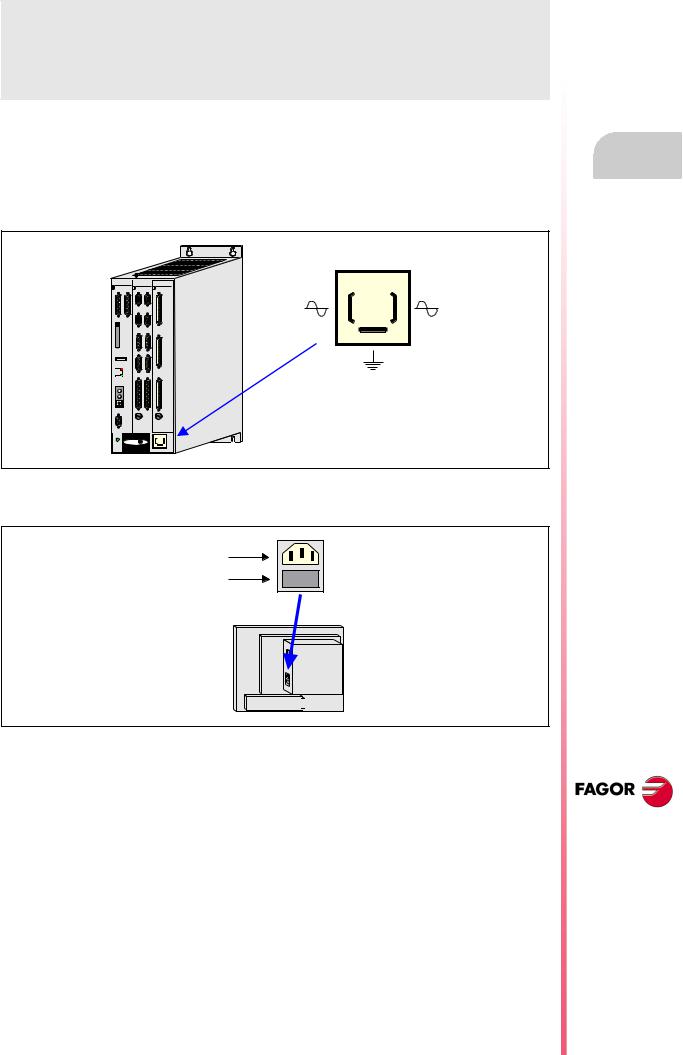
ADDITIONAL REMARKS
Mount the CNC away from coolants, chemical products, blows, etc. which could damage it. Before turning the unit on, verify that the ground connections have been properly made.
To prevent electrical shock at the central unit of the 8055 CNC, use the proper mains AC connector at the power supply module. Use 3-wire power cables (one for ground connection).
CPU |
|
AXES |
|
I/O |
X1 |
X2 X1 |
X2 |
X1 |
|
|
|
X3 |
X4 |
|
CMPCT |
X5 |
X6 |
X2 |
|
FLASH |
|
|
|
|
USB |
|
X7 |
X8 |
|
|
ETH |
|
X10 |
|
|
|
X9 |
X3 |
|
|
|
|
||
COM1 |
|
|
|
|
X3 |
|
|
|
|
|
FAGOR |
|
|
|
To prevent electrical shock at the monitor of the 8055 CNC, use the proper mains AC connector (A) with 3-wire power cables (one of them for ground connection).
(A)
(B)
X1
W1 

Before turning on the monitor of the 8055 CNC and verifying that the external AC line (B) fuse of each unit is the right one. See identification label of the unit itself.
In case of a malfunction or failure, disconnect it and call the technical service. Do not get into the inside of the unit.
CNC 8055
CNC 8055i
·21·

Additional remarks
CNC 8055
CNC 8055i
·22·
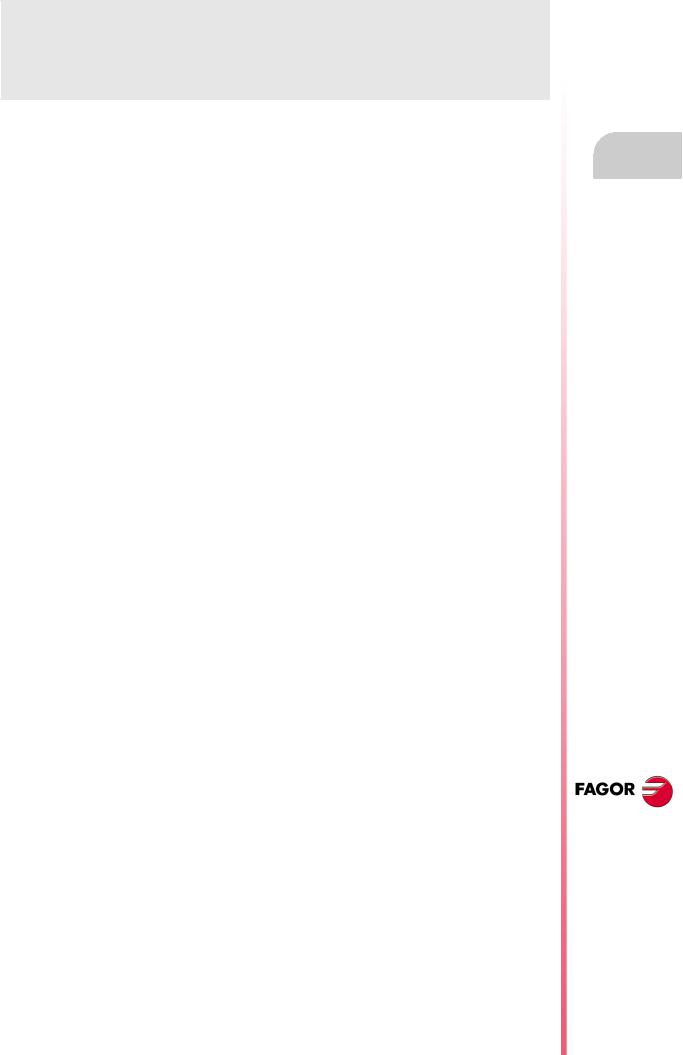
FAGOR DOCUMENTATION
OEM manual
It is directed to the machine builder or person in charge of installing and starting-up the CNC.
USER-M manual
Directed to the end user.
It describes how to operate and program in M mode.
USER-T manual
Directed to the end user.
It describes how to operate and program in T mode.
MC Manual
Directed to the end user.
It describes how to operate and program in MC mode.
It contains a self-teaching manual.
TC Manual
Directed to the end user.
It describes how to operate and program in TC mode.
It contains a self-teaching manual.
MCO/TCO model
Directed to the end user.
It describes how to operate and program in MCO and TCO mode.
Examples-M manual
Directed to the end user.
It contains programming examples for the M mode.
Examples-T manual
Directed to the end user.
It contains programming examples for the T mode.
WINDNC Manual
It is directed to people using the optional DNC communications software. It is supplied in a floppy disk with the application.
WINDRAW55 Manual
Directed to people who use the WINDRAW55 to create screens.
It is supplied in a floppy disk with the application.
CNC 8055
CNC 8055i
·23·

Fagor documentation
CNC 8055
CNC 8055i
·24·
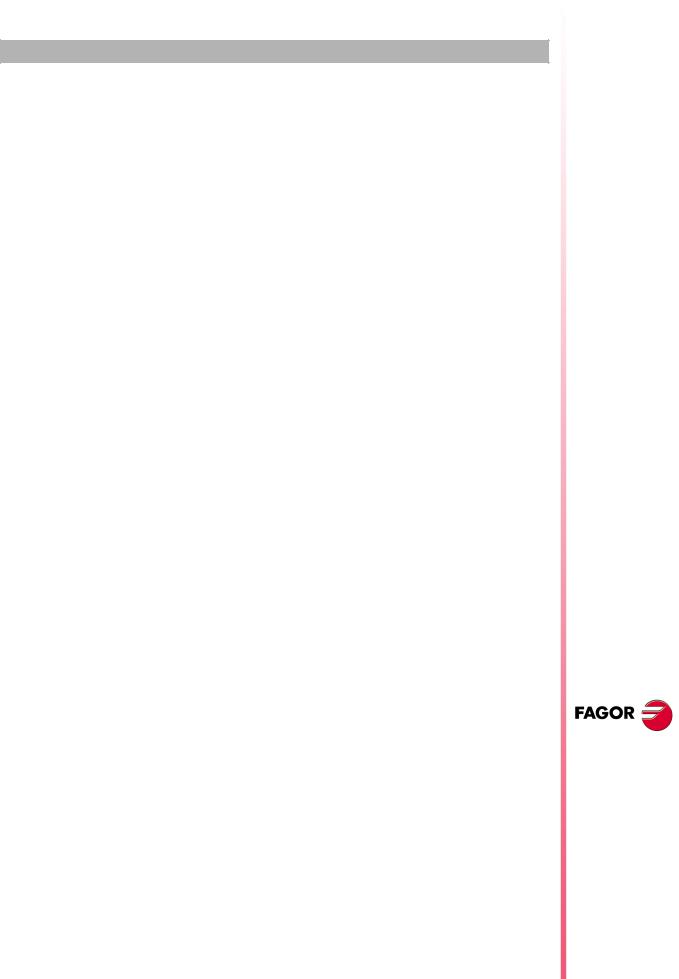
GENERAL CONCEPTS
1
The CNC may be programmed at the machine (from the front panel) and from a peripheral (computer). Memory available to the user for carrying out the part programs is 1 Mbyte.
The part programs and the values in the tables which the CNC has can be entered from the front panel, from a pc (DNC) or from a peripheral.
Entering programs and tables from the front panel.
Once the editing mode or desired table has been selected, the CNC allows you to enter data from the keyboard.
Entering programs and tables from a Computer (DNC) or peripheral device.
The CNC allows data to be exchanged with a computer or peripheral device, using the RS232C serial line.
If this is controlled from the CNC, it is necessary to preset the corresponding table or part program directory (utilities) you want to communicate with.
Depending on the type of communication required, the serial port machine parameter "PROTOCOL" should be set.
"PROTOCOL" = 0 If the communication is with a peripheral device.
"PROTOCOL" = 1 If the communication is via DNC.
CNC 8055
CNC 8055i
·T· MODEL
SOFT: V01.4X
·25·

1.
GENERAL CONCEPTS |
Part programs |
CNC 8055
CNC 8055i
·T· MODEL
SOFT: V01.4X
Programming manual
1.1Part programs
The operating manual describes the different operating modes. Refer to that manual for further information.
Editing a part-program
To create a part-program, access the –Edit– mode.
The new part-program edited is stored in the CNC's RAM memory. A copy of the part-programs may be stored in the hard disk (KeyCF) at a PC connected through the serial line or in the USB disk.
To transmit a program to a PC through the serial, proceed as follows:
1.Execute the "WinDNC.exe" application program at the PC.
2.Activate DNC communications at the CNC.
3.Select the work directory at the CNC. It is selected from the –Utilities– mode, option Directory \Serial L \Change directory
In –Edit– mode, it is possible to modify part-programs residing in the CNC's RAM memory. To modify a program stored in the hard disk (KeyCF), in a PC or in the USB disk, it must be previously copied into RAM memory.
Executing and editing a part-program
Part-programs stored anywhere may be executed or simulated. Simulation is carried out in the –Simulation– mode, whereas the execution is done in the –Automatic– mode
When executing or simulating a part-program, bear in mind the following points:
•Only subroutines stored in the CNC's RAM memory can be executed. Therefore, to execute a subroutine stored in the hard disk (KeyCF), in a PC or in the USB disk, it must be first copied into the CNC's RAM memory.
•The GOTO and RPT instructions cannot be used in programs that are executed from a PC connected through the serial line.
•From a program in execution, it is possible to execute another program located in RAM memory, in the hard disk (KeyCF) or in a PC using the EXEC instruction.
The user customizing programs must be in RAM memory so the CNC can execute them.
–Utilities– operating mode.
The –Utilities– mode, lets display the part-program directory of all the devices, make copies, delete, rename and even set the protections for any of them.
·26·

Programming manual
Operations that may be carried out with part-programs.
|
RAM |
Hard |
DNC |
|
memory |
disk |
|
|
|
|
|
See the program directory of ... |
Yes |
Yes |
Yes |
See the subroutine directory of ... |
Yes |
No |
No |
|
|
|
|
Create the work directory from ... |
No |
No |
No |
Change the work directory from ... |
No |
No |
Yes |
|
|
|
|
Edit a program from ... |
Yes |
Yes |
No |
Modify a program from ... |
Yes |
Yes |
No |
Delete a program from ... |
Yes |
Yes |
Yes |
|
|
|
|
Copy from/to RAM memory to/from ... |
Yes |
Yes |
Yes |
Copy from/to HD to/from ... |
Yes |
Yes |
Yes |
Copy from/to DNC to/from ... |
Yes |
Yes |
Yes |
|
|
|
|
Rename a program from ... |
Yes |
Yes |
No |
Change the comment of a program from ... |
Yes |
Yes |
No |
Change the protections of a program from ... |
Yes |
Yes |
No |
|
|
|
|
Execute a part-program from ... |
Yes |
Yes |
Yes |
Execute a user program from ... |
Yes |
Yes |
No |
Execute a PLC program from ... |
Yes |
No |
No |
Execute programs with GOTO or RPT instructions from ... |
Yes |
Yes |
No |
Execute subroutines residing in ... |
Yes |
No |
No |
Execute programs with the EXEC instruction, in RAM from ... |
Yes |
Yes |
Yes |
Execute programs with the EXEC instruction, in HD from ... |
Yes |
Yes |
Yes |
Execute programs with the EXEC instruction, in DNC from ... |
Yes |
Yes |
No |
|
|
|
|
Open programs with the OPEN instruction, in RAM from ... |
Yes |
Yes |
Yes |
Open programs with the OPEN instruction, in HD from ... |
Yes |
Yes |
Yes |
Open programs with the OPEN instruction, in DNC from ... |
Yes |
Yes |
No |
|
|
|
|
Via Ethernet: |
|
|
|
See from a PC the program directory of ... |
No |
Yes |
No |
See from a PC the subroutine directory of ... |
No |
No |
No |
See from a PC, a directory in ... |
No |
No |
No |
|
|
|
|
(*) If it is not in RAM memory, it generates the executable code in RAM and it executes it.
Ethernet
When having the Ethernet option and if the CNC is configured as another node within the computer network, the following operations are possible from any PC of the network:
•Access the part-program directory of the hard disk (KeyCF).
•Edit, modify, delete, rename, etc. the programs stored on the hard disk.
•Copy programs from the hard disk to the PC and vice versa.
To configure the CNC as another node within the computer network, see the installation manual.
1.
GENERAL CONCEPTS |
Part programs |
CNC 8055
CNC 8055i
·T· MODEL
SOFT: V01.4X
·27·

1.
GENERAL CONCEPTS |
Part programs |
CNC 8055
CNC 8055i
·T· MODEL
SOFT: V01.4X
Programming manual
1.1.1Considerations regarding the Ethernet connection
When configuring the CNC as another node in the computer network, the programs stored in the hard disk (KeyCF) may be edited and modified from any PC.
Instructions for setting up a PC to access CNC directories
To set up the PC to access the CNC directories, we recommend to proceed as follows.
1.Open the "Windows Explorer"
2.On the "Tools" menu, select the "Connect to Network Drives" option.
3.Select the drive, for example "D".
4.Indicate the path. The path will be the CNC name followed by the name of the shared directory. For example: \\FAGORCNC\CNCHD
5.When selecting the option: "Connect again when initiating the session", the selected CNC will appear on each power-up as another path of the "Windows Explorer" without having to define it again.
Data format
This connection is established through Ethernet and, therefore, the CNC does not control the syntax of the programs while they are received or modified. However, whenever accessing the program directory of the Hard Disk (HD), the following verification takes place:
File name.
The file number must always have 6 digits and the extension PIM (for milling) or PIT (for lathe).
Examples: |
001204.PIM 000100.PIM 123456.PIT 020150.PIT |
If the file has been given the wrong name, for example: 1204.PIM or 100.PIT, the CNC will not change it, but it will display it with the comment "****************". The file name cannot be modified
at the CNC; it must be edited from the PC to correct the error.
File size.
If the file is empty (size = 0) the CNC will display it with the comment "********************".
The file can be edited or deleted either from the CNC or from the PC.
First line of the program.
The first line of the program must have the % character, the comment associated with the file (up to 20 characters) and between the two commas (,) the program attributes O (OEM), H (hidden), M (modifiable), X (executable).
Examples: %Comment ,MX,
% ,OMX,
If the first line does not exist, the CNC will display the program with an empty comment and with the modifiable (M) and executable (X) attributes.
When the format of the first line is wrong, the CNC does not modify it, but it displays it with the comment "****************". The file can be edited or deleted either from the CNC or from the
PC.
The format is incorrect when the comment has more than 20 characters, a comma (,) is missing to group the attributes or there is a strange character in the attributes.
·28·

Programming manual
1.2DNC connection
The CNC offers as optional feature the possibility of working in DNC (Distributed Numerical Control), enabling communication between the CNC and a computer to carry out the following functions:
•Directory and delete commands.
•Transfer of programs and tables between the CNC and a computer.
•Remote control of the machine.
•The ability to supervise the status of advanced DNC systems.
1.
GENERAL CONCEPTS |
DNC connection |
CNC 8055
CNC 8055i
·T· MODEL
SOFT: V01.4X
·29·

1.
GENERAL CONCEPTS |
DNC or peripheral device |
|
Communication protocol via |
CNC 8055
CNC 8055i
·T· MODEL
SOFT: V01.4X
Programming manual
1.3Communication protocol via DNC or peripheral device
This type of communication enables program-and-table transfer commands, plus the organization of CNC directories such as the computer directory, for copying/deleting programs, etc. to be done either from the CNC or the computer.
When you want to transfer files, it is necessary to follow this protocol:
•The "%" symbol will be used to start the file, followed by the program comment (optional), of up to 20 characters.
Then, and separated by a comma ",", comes the protection of each file, read, write, etc. These protections are optional and need not be programmed.
To end the file header, RT (RETURN ) or LF (LINE FEED) characters should be sent separated by a comma (",").
Example: |
%Fagor Automation, MX, RT |
•Following the header, the file blocks should be programmed. These will all be programmed according to the programming rules indicated in this manual. After each block, to separate it from the others, the RT (RETURN ) or LF (LINE FEED) characters should be used.
Example: |
N20 G90 G01 X100 Y200 F2000 LF |
|
(RPT N10, N20) N3 LF |
If communication is made with a peripheral device, you will need to send the ‘end of file’ command. This command is selected via the machine parameter for the serial port: "EOFCHR", and can be one of the following characters :
ESC |
ESCAPE |
EOT |
END OF TRANSMISSION |
SUB |
SUBSTITUTE |
EXT |
END OF TRANSMISSION |
·30·
